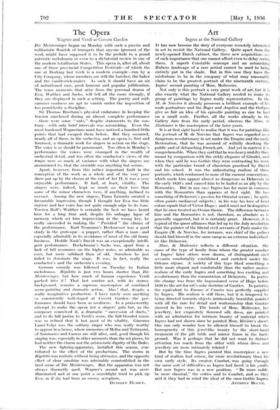Art
Ingres at the-National Gallery IT has now become the duty of everyone remotely, interested iii art to revisit the National ,Gallery. Quite apart from the
newly ,opened Dutch cabinet, the three new acquisitions are of such importance that one cannot afford even to delay seeing them. A superb Constable seascape and an astonishing
Rubens landscape of a rare period cannot be used to being entirely put in the shade. But in this case they have the misfortune to be in the company of what may reasonably claim to be the greatest portrait of the nineteenth century, Ingres' second painting of Mme. Moitessier, Not only is this portrait a very great work of art, but it is also exactly what the National Gallery needed to make its group of paintings by Ingres really representative. In the M. de Norvins it already possesses a brilliant eirtimple.of his Male portraiture and the Roger and Angelica and the Oedipus give as fair an idea of his episodic painting as can be had on a small scale. Further, all the works already in the Gallery date front the early period, whereas the Mme. de Moitessier is the masterpiece of the later years.
It is at first sight hard to realise that it was for paintings like the portrait of M. de Norvins that Ingres was regarded as a dangerous revolutionary in art under the Empire and the early Restoration, that he was accused of wilfully shocking the public and of debauching French art. And yet in context it is comprehensible. When they said that he was heavy and dry. they nieant by comparison with the sickly elegance Of GirOdet, and when they said lie was Gothic they were contrasting;his work with the particular brand Of classicism practised David and his school. It was the unhesitating realisni 'of these portraits, which conformed to none of the current conventions, which made him appear almost 'as dangerous as Delacroik. in the early 1820's and caused him to be hailed as an ally by time Romantics. But in any cas3 Ingres has far more in' common with the Romantics than apPears at first sight He has something of Delacroix's passion for Oriental scenes.; he quite often paints mediaeval subjects ; in his way his love of local colour equals that of Victor Hugo ; and it must not be forgotten that he once treated an Ossian theme. The differenoe.between him and the Romantics . is not, therefore, as absolute as is generally suggested, but it is certainly great. However, it is typical of the queer alliances that led up to the July revolution that the painter of the liberal civil servants of Paris under the Empire (M. de Norvins, for 'instance, was chief of the police) should find himself in the same camp as an extreme individual-
ist like Delacroix. • . •
Mme. de Moitessier reflects a different situation. She came of the type of family from whom the greater number of Ingres' later sitters were 'drawn, of . distinguished, civil servants comfortably• established and enriched under the Orleans regime. A society. of this type liked something a little more elegant and comfortable than the rather austere realism of the early Ingres and something less exciting and revolutionary than the romanticism of Delacroix. In poetry the Change was from the impassioned verse of Hugo before 1830 to the art-for-art's-Sake doctrine of Gautier. In painting the equivalent to Entatq et Camees was perfectly supplied by. Ingres. His realism is still there, but it is tempered by being directed towards objects intrinsically beautiful, painted with all the care for detail and workmanship that Gautier showed in his verse. The hands of: Mme. Moitessier, her jewellery, her exquisitely flowered silk dress, ire. painted with an admiration for intrinsic beauty of material which Ingres had not shown since he painted Mine. Riviere's shawl. One. can only -wonder how he alloWed himself to break the hothogeneity of this jeivel-like beauty by the -short-hand treatment of the gilt table and mirror frame in the back- ground. Was it perhaps that he did not want to distract attention too much from the sitter with whom 'dreas and jewellery arc more intimately related ?'
But by the time Ingres painted this Masterpiece a new kind of realism had arisen, far more revolutionary than his own early style. Its creator, Courbet, was going through the same sort of difficulties as Ingres had faced his south. But now Ingres was in a new position. "-Be more noble, be more classical," the critics- said to Courbet, and• as they said it they had in mind the •ideal of the once Gothic -Ingres.














































 Previous page
Previous page